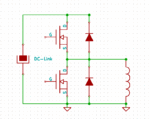Orson Cart
Advanced Member level 3
- Joined
- Jun 18, 2009
- Messages
- 798
- Helped
- 347
- Reputation
- 1,146
- Reaction score
- 558
- Trophy points
- 1,373
- Location
- New Zealand
- Activity points
- 5,973
Yes, having minimal dead time reduces the amount of charge carriers picked up by the internal diode, with the internal mosfet shorting the internal diode these diodes aren't fully off (junction swept of charge and reversed biased) when hit by the other fet turning on.... depending on how fast you are switching some small snubbers will help get the spike down, say 330pF and 33 ohm across each fet as a starting point...
- - - Updated - - -
Actually a slightly faster turn on of your upper devices may help if it shortens the dead time....
- - - Updated - - -
Sorry that should be 2.2nF (1kV) and 10 ohm (2W) across each fet...
- - - Updated - - -
Actually a slightly faster turn on of your upper devices may help if it shortens the dead time....
- - - Updated - - -
Sorry that should be 2.2nF (1kV) and 10 ohm (2W) across each fet...
